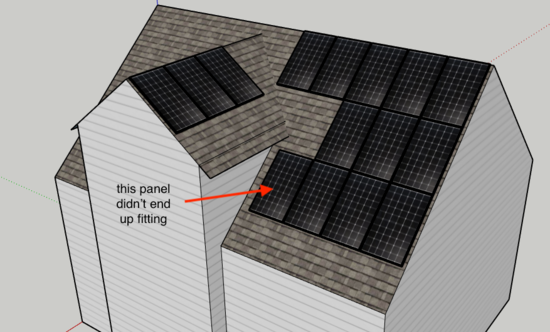Last fall we had solar panels installed. Our roof is pretty marginal for solar, large parts blocked by trees and the remainder mostly facing West, but incentives were high enough that it looked decent. And even if it only broke even I still liked it for the resiliency advantages. It’s currently doing slightly better than expected, so I’m happy!
We have fourteen LG Neon-R 360 watt panels, three facing South and eleven facing West:
The installers predicted we would see 3.45MWh in the first year, slowly ramping down to 3.25MWh/y over the next twenty five years as the panels degrade. After a year of operation, we’ve seen 3.95MWh. This includes three short periods in March, April, and August where the system turned itself off and needed to be reset by the installer. This is covered by our extended warranty, but does make me nervous about its long-term robustness.
One of the bigger risks I saw going into this was that the installers had a lot of incentive to overestimate our production, so I’m glad that while it was only in operation about 96% of the year it still made ~14% more power than expected.
Four MWh is not a huge amount of electricity, however. At wholesale rates of ~$40/MWh (pdf) this would be just $160. MA has net metering, however, which means we can subtract the power generated from our bill. Our (retail) rate is $214/MWh, so this is $844 for the year. The whole system cost $26k, so this doesn’t break even within the system’s lifetime, and that’a ignoring opportunity cost.
There are additional incentives, however: a 30% federal tax credit, a $1k MA tax credit, and SREC II generation incentives. The tax credits bring the effective cost down to $17k, and the generation incentives give us ~$500/y-$700/y for the first ten years. This gives 11-13 years until payback, and if we figure a 25 year lifetime (the length of the warranty) and electricity going up 3%/y it’s equivalent to an investment returning a nominal ~9%.
So while I don’t think rooftop solar makes much sense for society (unless we required systems to function during power outages, which we don’t) and our roof is marginal for solar, it does look like our system is working out from a self-interested perspective.
Comment via: facebook

I realize this post is 4 years old but I just found it and am glad to see it discussed. Any updates after another 4 years?
First, this is a way better result than was typical a decade or two prior, when installers were else experienced and equipment less well developed. Then it often wasn’t possible to get payback within panel lifetime even with subsidies.
Just back-of-envelope it seems like you’re getting about half of what a more optimal location for panels would be in MA. A more optimal roof would have a much shorter payback period
Also: the big issue for economics of home solar is installation costs, it’s just not that efficient in labor and balance of system. I wonder if larger systems (more panels covering more roof area) end up being lower $/watt because of that?
Another issue is that rooftop panels don’t get angled throughout the day. This may be less of an issue in the future as we get more commercial scale-up of non-Si panels that are less sensitive to sun intensity, sun angle, and shade, but that’s still a ways off (early 2030s for significant penetration of the market).
Still producing power, looks very similar.
We had some issues with arc faults, which the installers fixed: https://www.jefftk.com/p/solar-arc-faults
The tree to our south east was cut down, and I tried to get more panels, but wasn’t able to add them to the existing system without messing with the subsidies, and wasn’t able to add a new system with any sort of emergency backup feature, so decided not to.